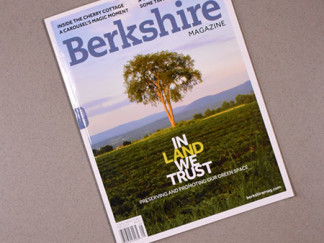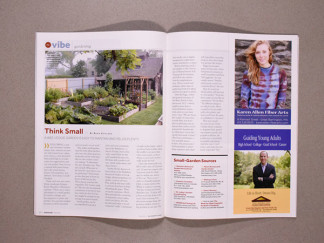My work as a magazine writer for national and regional publications like Berkshire Magazine has allowed me to get creative on a variety of topics, from visual arts to culture, food, dance, human interest pieces, outdoor recreation, and even gardening. Editorial and feature writing offer storytelling freedom that shorter forms frequently don’t, so even though many of us read primarily in digital form these days, I still look forward to magazine writing assignments.
Think Small
A wee veggie garden is easy to maintain and yields plenty
By Robin Catalano
Following a summer of farmers’ market tomato lust, wherein my partner and I spent hours ogling rows of juicy, color-drenched fruits piled high in wooden crates, he suggested we start our own garden. Sure, he was a natural with green things, but I, the serial-slaying Dexter of houseplants, was dubious. “Let’s keep it small,” I hedged.
Turns out I was on to something. Landscape designer Karen Shreefter of Monterey, Massachusetts, explains, “There are so many advantages to a small garden. It’s easier to design, and less expensive to plant and fertilize. You can feel satisfied because it will be beautiful and not need a ton of work.”
This makes small gardens ideal for both urban dwellers who have less-than-generous backyards and for rural types like me who eschew extensive upkeep. To determine the size, Shreefter says, “First ask yourself, What part of the land do I not want to use for gardening?” Next locate an area that gets at least six hours of full sun per day. Then choose your favorite vegetables. For “tomato junkies” like me, she recommends a minimum of 6 feet by 4 feet, while 5 feet by 4 feet might be enough for the average four-person family. Small gardens can be accomplished in ground plots and even containers, but in the Berkshires—a haven of rocky, heavy clay soils—raised beds are the gold standard, because the soil warms faster and drains better, with little tilling required.
Dorthe Hviid, director of horticulture at the Berkshire Botanical Garden in Stockbridge, Massachusetts, advises prepping your garden a year in advance. First pull up any large rocks to prevent frost heaves from disturbing the space. Then set up the enclosure; Hviid likes premade kits consisting of aluminum corner stakes, which are driven into the ground, and cedar or wood-composite “walls” a minimum of 8 inches high—taller if you have back troubles. Keep the width to no more than twice your reach, or about 4 feet, so you won’t need to walk inside the bed.
Once the framework is set, fill it with a mix of 70 percent soil, 25 percent compost, and 5 percent sand (for drainage) to within two inches of the top. Then cover it with eco-friendly landscape fabric to keep weeds at bay. When it comes to watering, “the key is long and slowly,” Shreefter says. “A spray with a hose won’t get down to the roots. And watering from above encourages fungi, like powdery mildew, which is a big problem in our area.” For best results, she suggests a simple, inexpensive soaker-hose system attached to a timer.
Before planting, send a soil sample to the University of Massachusetts Soil Testing Lab for analysis, and follow any instructions for supplementation. Then consult seed packages, plant tags, or gardening books for when and how far apart to plant. Dale-Ila Riggs, owner and general manager of the Berry Patch in Stephentown, New York—which supplies more than a dozen Berkshire restaurants, plus its own farm store—says, “We get those first couple of warm days in early May, but don’t plan on planting your tomatoes then unless you’re prepared for heartbreak; we often have a frost during the first week of June.” (She loves cold frames—tiny, portable greenhouses—for protection.) And remember to plant those tomatoes and other tall vegetables toward the back, so they don’t shade low growers like lettuce.
Riggs favors many space-saving crops—from determinate tomatoes to small cucumbers and Fairy Tale eggplant—for one simple reason: “They often taste better. The smaller plant packs a more concentrated flavor,” she says. How do you know which plants will fare best in your garden? “Treat the first couple of years like an experiment,” Hviid shares. “Try different things to see which work. Allow yourself to be successful with a few plants, and then you’ll have the sense of confidence to try more.”
That was the exactly the case for me. From vibrant cherry tomatoes to fragrant basil, sprawling summer squash, and piquant scallions, the garden was a beautifully successful experiment. And this year, I can’t wait to get back into our newly expanded “lab.”
Our Experts’ Favorite Sources
Western Massachusetts Master Gardeners
On Mondays from April to October, ask a certified Master Gardener your horticultural question; you can also call this free service anytime throughout the year: 413.298.3926
The Week-by-Week Vegetable Gardener’s Handbook by Ron and Jennifer Kujawski (Storey Publishing, 2010)
UMASS Soil Tesing Lab
http://extension.umass.edu/floriculture/services/soil-testing
Country Caretaker
13418 New York 22, Canaan, NY
(518) 781-4495
countrycaretakers.com
Dr. Lahey’s Garden & Landscaping
1032 South St., Pittsfield
(413) 443-7321
Ward’s Nursery and Garden Center
600 South Main Street, Great Barrington
(413) 528-0166
wardsnursery.com
Whitney’s Farm
1775 South State Rd. (Rt. 8), Cheshire, MA
(413) 442-4749
whitneysfarm.com
Zema’s Nursery
154 Presbyterian Hill Rd., Stephentown, NY
(518) 733-5868
zemasnursery.com

